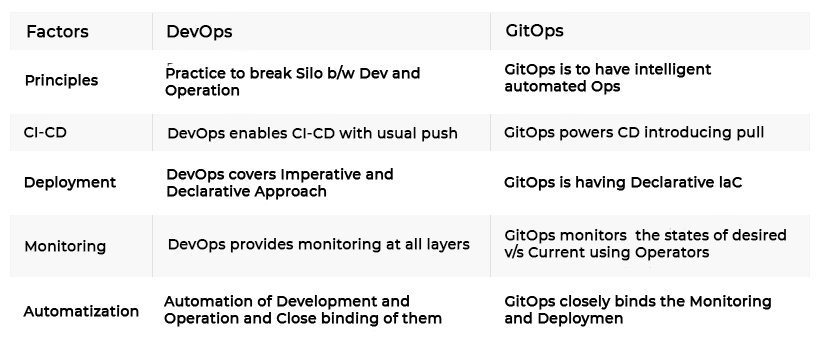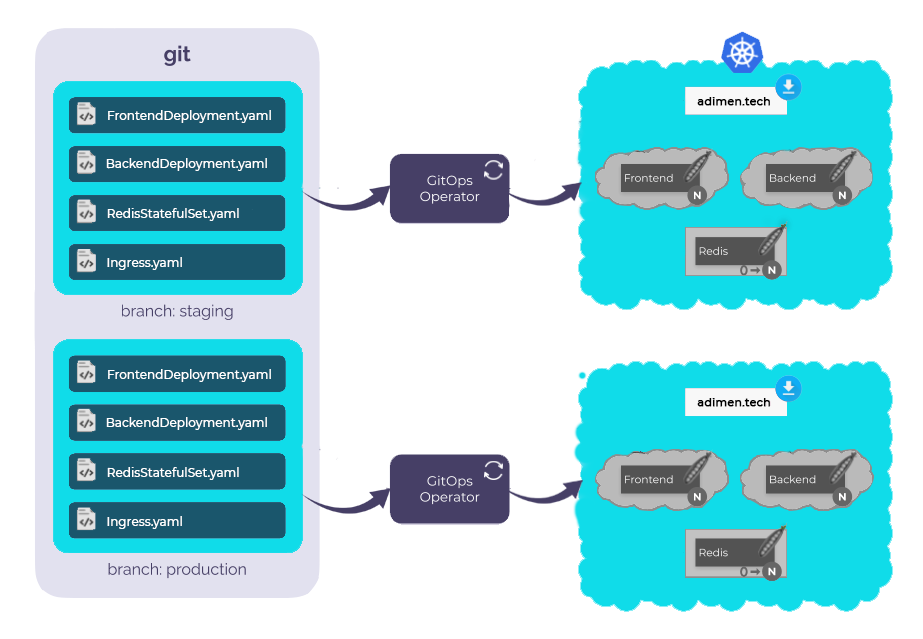Top 7 Benefits of GitOps: How to Reinforce Your Software Productivity and Accelerate Business Success
Today’s world regards time as of paramount importance. This said, the disruptive tech-enabled innovations are foremost meant to save both business owners’ and users’ time. The industry of software development is based upon the same postulates – the sooner means the better, provided that timely product deliverables are coupled with efficiency and convenience.
The Continuous integration (CI) and continuous delivery (CD) practices are among popular software engineering industry trends that help cut costs, time, and risks of changes delivering. Yet another trend to optimize the industry lies in applying DevOps (Development Operations) methods, oriented to increase the efficiency of development and operation processes, and to speed up the product delivery.
Since the industry is on the rise now, new technologies are more than welcome. Here comes an innovative approach that may change the entire software development landscape. Much like DevOps and CI/CD, GitOps follows the same application development principles while making them even more effective when applied to infrastructure automation. It makes the whole process of delivering viable software applications to customers much easier. What’s more, software deployment and delivery times have become way shorter than ever.
The key differences between GitOps and DevOps are illustrated below:

The Guide to GitOps: What GitOps practices really mean
What is GitOps in easy words? This approach appeared as a set of methods for simplifying control processes for managing and rolling out container-based applications. GitOps utilizes the infrastructure-as-a-code idea that claims the same role as the DevOps methodology plays for app deployment.
The term “GitOps” was introduced by Weaveworks CEO Alexis Richardson. Weaveworks raised the awareness of this approach, implementing GitOps on apps managed by Kubernetes. Given this, the method is understood as the most correlated with Kubernetes platform while GitOps may theoretically work with other platforms as well.
What sequences stand behind GitOps?:
- Developers request for a merge with a new feature.
- A code is aimed to be checked and approves, then it merges with the codebase.
- The CI/CD pipeline automatically updates the changes within an application.
- Software agents receive update notifications, download new versions of a code for updating their settings files.
- Within Kubernetes, software agents change the setting file status to mention previous settings as outdated. Then agents download and deploy a new app’s version.
According to Atlassian, GitOps is the next stage of ideas development brought by the DevOps approach. The new methodology is geared to solve the most vital issues connected with software development and deployment, moving the sector of shared cloud-based apps into the new level.

What are the principal benefits of GitOps?
While talking about the core benefits of the GitOps approach, experts point out the following pros:
- Automatization. GitOps makes it possible to reject any manual changes to Kubernetes. The operator is responsible for all the synchronization process and does it entirely automatically.
- Convergence. The system is always oriented to automatized synchronization, and even in case of some failures (manual or unauthorized changes in Kubernetes , Git changes that are not delivered to Kubernetes), the GitOps operator aims to synchronize all the processes soon.
- Idempotence. Users are able to repeat the synchronization process again, and the first synchronization doesn’t affect the next ones.
- Determinism. Kubernetes images are determined by the Gits; hence, Gits are the subordinate participants in such a system.
- Observability. Users get access to request the system status at any time to define whether it is synchronized. In the case of desynchronization, users may receive “alert” signals.
- Audit. GitOps empowers users with the capability to monitor conveniently all changes delivered to Kubernetes.
- Security. The approach prohibits direct access of the CI/CD system to the Kubernetes cluster.
With all that said, GitOps is a solution to make the software engineering industry more effective, secure, and convenient for all the stakeholders.
Who can profit from leveraging GitOps?
Speaking of a wide range of benefits it brings to businesses, let’s figure out who exactly can harness the immense potential of Gitops. First and foremost, these are DevOps departments as well as software developers seeking robust operational solutions for application development and infrastructure automation. To be specific, the following experts can surely improve their performance and productivity via tapping into the GitOps approach:
- Chief Information Officers and IT Vice Presidents. Such specialists are usually heads of both engineering and operating teams, and GitOps helps increase working processes’ efficiency.
- IT Infrastructure managing specialists. These employees frequently face the necessity to cut expenses for the organization, and the GitOps approach makes it possible to accomplish the task.
- Platform Engineering managers. The approach empowers such specialists to coordinate the working process between diverse development teams.
Truth be told, the scope of GitOps beneficiaries is quite large and potentially covers way more business audiences and use cases.
Stages of GitOps implementations
The benefits of the GitOps approach for optimizing software development and deployment processes are evident. In the meanwhile, potential customers are interested in how to make use of the GitOps Kubernetes alignment, given that Git is understood as the only source of trustworthy information for all infrastructure and apps deployments.
Here’re some basic steps you should take first-hand:
- Foremost, you need to complete the entire system description and version it in a Git group.
- Check the correct placing of repository files inside a Git group to avoid misconfiguration and other failures.
- Apply the approved changes to the Kubernetes state for starting the synchronization processes.
- Test the system for its appropriate synchronized functioning to avoid divergence with software agents.
Further steps are more business-specific. If interested, you are welcome to reach out to our GitOps experts to get more details regarding your individual business needs.
GitOps Vs DevOps: it’s high time to streamline the progress
While talking about improvements, the UpGuard statistics show that companies step-by-step implement DevOps solutions to improve their efficiency. 63% of organizations accentuate this approach succeeded to improve the quality of software deployments and speed up development processes. Furthermore, Statista shows that the annual growth of companies that fully embraced DevOps is about 7%.
Meanwhile, GitOps is a new trend on the software engineering map, and organizations have unique chances to skip to another level. The implementation process is somehow complicated, demanding the mix of special knowledge and approach comprehension. On the other hand, the juice is worth the squeeze, as the methodology is about to cut time expenses by about 40% and save more than 28 hours monthly on communication, making the process entirely automatized.
Compare the pros and expenses for GitOps implementation and remember that efficiency is directly correlated with a developer-company. With our many years’ experience on the market, we guarantee beneficial conditions for every customer. We are always one step ahead providing our clients with recent tech-enabled innovations.